The curious case of sending a cold email: Will it head to spam straightaway? Will it be opened? Will it at least be read before being thrown in the bin? Even with so many unanswered questions, cold email is still a popular outbound sales channel, with the market now flooded with 30+ cold emailing tools.
Here are a few phenomenal entrepreneurial journeys that began with a cold email.
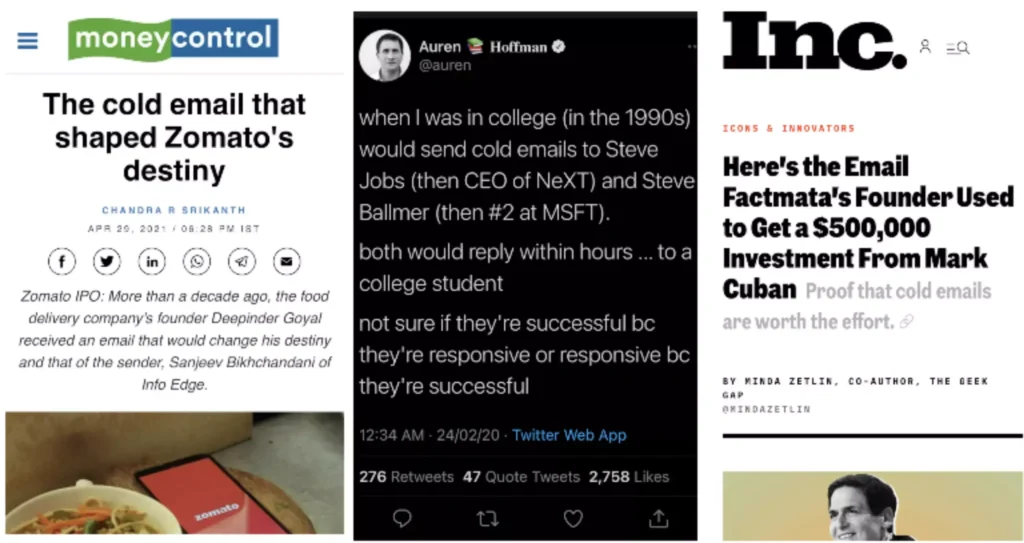
Our point being, cold email is an effective way to generate leads.
But here's the hitch.
There's an overwhelming number of emails bombarding people every day. There are also studies confirming that people's attention span is dwindling.
You don't want your little missive to be buried in a sea of other emails, or worse, be chucked into spam.
So how do you write a cold email that gets your potential clients to respond? It has to answer the three questions the prospect will have when they receive an email from a stranger: Who are you? Why should I care? What do you want from me?
Before we explain how to write effective cold emails, we break down the basics.
What Is a Cold Email?
A cold email is an email sent to a person who has no prior relationship with you or your company or has not even heard of your company (therefore, cold).
People send cold emails for a lot of reasons–to find a job, to hire someone, to raise funds, to invest in ideas, to network, to sell a product or service, to build relationships, etc.
In sales, a cold email is one of the first touchpoints in the multistep, multichannel outreach strategy sales reps use to book meetings with prospects. Every cold email will have a primary goal–like booking a meeting with the prospect, getting the prospect to download a piece of content your business made, driving the prospect to your website's pricing page, or whatever you'd want them to do after reading your email.
How To Write a Cold Email?
Anyone can write cold emails. But to write ones that get replies, you need to know the perfect cold email structure. We break down the different components that make a cold email great into: 1. From line, 2. Subject line, 3. Email body, 4. CTA, 5. Email signature.
Step 1: Create a From Line
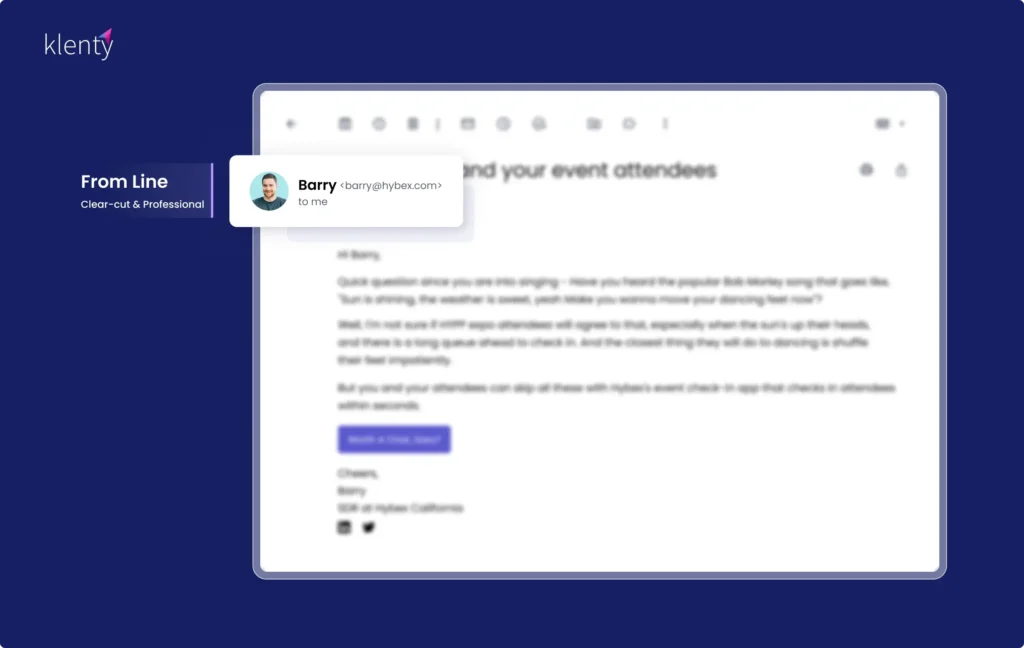
Suppose there are 3 emails in your prospect's inbox. One's from [email protected], one from Cerena, and another from Andrew from Hybex.
Which one would they send to spam without a second thought?
Yes, the email address [email protected] looks spammy and unprofessional. Thus, avoid sending emails from such addresses unless you want to earn a one-way ticket to spam.
What about the 'from line', Cerena? Will they open it? Maybe. This is because personal email addresses are not really the flagbearer of professionalism, and as such, nobody will take it seriously.
And Andrew from Hybex? This 'from line' looks professional, and thus they are more likely to trust you and what you are saying through your emails. On top of that, using a company email address ensures that they get familiar with your brand.
So, How Can You Ensure Your ‘From Line’ Looks Trustworthy?
- Avoid sending emails from spammy-looking addresses like [email protected].
- Use a professional email address and mention your name and company in the 'from line'.
- If you're using a personal address, add an email signature so your reader can look you up on the internet.
Here Are 3 Good ‘From Line’ Examples:
- Grace Harvey [First Name, Last Name]
- Alex from HYPP [First Name from Company]
- Bruce Travis at Hybex [ First Name at Company]
Step 2: Write a Click-Worthy Subject Line
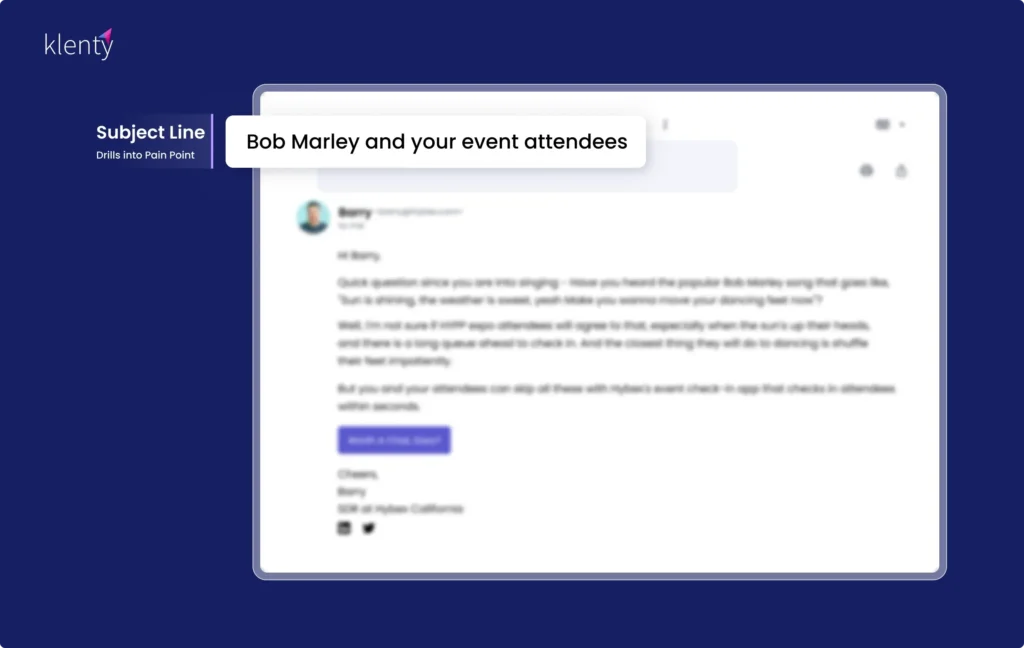
People judge your email by its subject line. In fact, 33% of email recipients decide whether to open an email or send it to spam based on subject lines. That means if your cold email subject lines don’t catch their eye, your emails get ignored, no matter how well-written.
How To Create Subject Lines Your Prospects Can’t Ignore?
a. Personalize your subject lines:
Emails with personalized subject lines get twice the open rates as emails with generic subject lines, according to a study we did at Klenty. This is because personalized subject lines convey to the prospects that the email is written for them and is thus important.
You can personalize subject lines in the following ways:
- Using basic details like name and company name
- Using professional updates like promotions, job switches, etc.
- Using prospect's personal interests like their hobby, favorite food, sports, etc.
b. Keep subject lines short:
The reason? More than 42% of emails are read on mobiles. And most mobile email apps display only the first 50 to 70 characters of the subject line. And that's around 7 to 10 words. Thus, having a short cold email subject line ensures your subject lines aren’t cut off midway due to a lack of screen space.
Here are some things you should consider while going for shorter subject lines:
- Add a subject line that gives the reader a peek into what your mail is about.
- Capitalize your email subject line only where it is necessary.
- Use power words in your subject line but ensure they aren't common spam trigger words.
Here's how to write short collar-yanking cold subject lines:
- If you want to part ways with the prospect, say - “Moving on”
- If you want to grab the prospect's attention and convey how little of their time you need, say - 26 seconds (or less)
Note: Short or long, your subject lines should intrigue your prospects to open your email. So, if you think a short subject won't give enough information to your prospects, go for that long subject line, but ensure it doesn't run more than 10 words.
c. A/B Test Your Subject Line
Average cold email open rates are between 20% and 40% But take this with a grain of salt because your open rates depend on many factors like your audience, industry niche, etc.And the only accurate way to find yours is to A/B test different subject lines.
Here's how you can A/B test your subject lines:
- Invest in a cold email software that allows A/B testing
- Choose the sample size and duration of the A/B testing
- Decide on the subject line variations you want to test
- Go for the subject line with the highest open rate
Here Are 3 Best Subject Line Examples:
- If the prospect is active on LinkedIn, talk about their latest post – Your comment on XYZ's post!
- If you want to grab the prospect's attention and convey how little of their time you need, say – 26 seconds (or less)
- If you share your hometown with the prospect, make it known. – Is 'Bestia' the 'Capital Grille' of Los Angeles? (In this example, the sender and the recipient come from Washington and are now in Los Angeles. The sender is comparing two famous restaurants, one in Washington and other in Los Angeles to start a conversation).
Best Subject Line Tester Tools
Subject line tester tools analyze your subject lines based on factors like industry standards, length, word count, etc., and give suggestions to improve them. Here are two such tools:
- Refine: Compares your subject line's open rate against industry standards and offers suggestions for improvement.
- Mailmeteor: Scores your subject line based on factors like length, word count, presence of emojis, and spam words.
Looking for more techniques to create a killer subject line? Read more here.
Step 3: Make Your Email Body Relevant to the Reader

Your prospect opened your email, and now there are two questions running through their minds:
- What do they want from me?
- What is in it for me? (WIIFT)
And it won't take them more than 5 seconds to figure this out. A quick glance and they'll notice the bare bones of an overused template sticking out or a case of forced personalized.
For instance, investment mogul Mark Cuban said on the "Raising The Bar" podcast that of the 750-1000 emails he gets a day, it takes him just 2 seconds to decide whether to respond to or delete it.
So, How To Make Your Cold Email Copy Engaging?
a. Start with a pattern interrupting introduction
Nope, before you judge our editors, that wasn't a typo. It was intentional. And the reason you noticed it? Because it was pattern interrupting. Your mind was expecting another sentence, and so when it saw strings of Ss, it immediately paid attention.
And that's how your prospect should react to your email introduction. It should make them go 'wait what?'. So how can you make your intros pattern interrupting?
- Stop introducing yourself or your product in the first few lines.
- Do not start with age-old intros like "Hope you are doing fine" or "I found your profile..".
- Catch them off guard by addressing their pain points or mentioning their competitors.
- Waltz in with an industry-specific joke.
Note: The CEO and founder of Flip The Script, Becc Holland, did us all a gigantic favor by compiling a list of words she noticed salespeople most commonly used in their LinkedIn pitches to her. So if the intention is to pattern interrupt, don't use these words and phrases.
Here’s a list of all words you should avoid during pattern interruption.
b. Explain What's In It For Them (WIIFT)
This is where you tell them why you emailed them. And it's tricky because here, your prospect gets to know the real reason for your email. And if they feel that you force personalized the email to get a meeting, they'll ignore you.
So, how can you ensure this doesn't happen? How can you deliver a sales pitch without sounding salesy? Here's how:
- Find a way to segue smoothly into the reason for your email. In other words, your introduction should tie to the reason for your call organically.
- Give them a reason for your email, why they should pay attention (relevance), and how it impacts them (benefit).
- Highlight your value proposition by mentioning past customers or specifying how you are different from competitors(without bad-mouthing).
Example of a Great Email Content:
Quick question since you are into singing - Have you heard the popular Bob Marley song that goes like, "Sun is shining, the weather is sweet, yeah Make you wanna move your dancing feet now"?
Well, I'm not sure if HYPP expo attendees will agree to that, especially when the sun's up their heads, and there is a long queue ahead to check in. And the closest thing they will do to dancing is shuffle their feet impatiently.
But you and your attendees can skip all these with Hybex's event check-in app that checks in attendees within seconds.
Step 4: Engage Prospects With a Call-To-Action
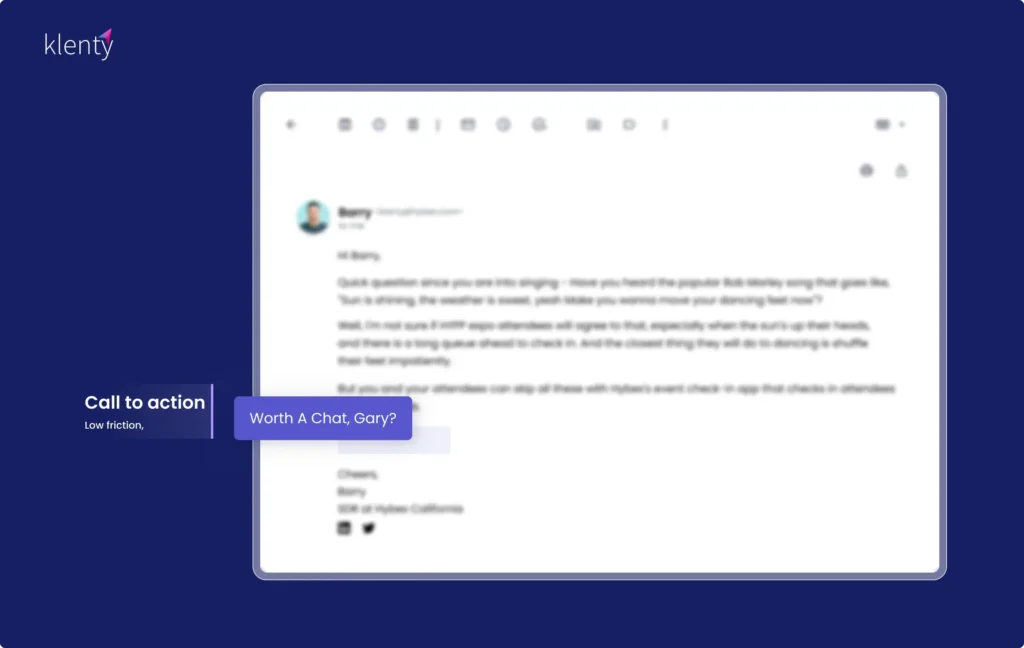
What do you want your prospects to do after they read your email? Do you want them to reply, download a resource, book a meeting, or start a free trial? Whatever the case, a call to action (CTA) is what prompts them to perform what you want them to do.
How Can You Craft a Compelling Call to Action?
Though your call-to-action depends on the context of your email and the response you want from the prospect, here are a few techniques to help you craft an exciting CTA.
a. Reiterate the Value Proposition
Reiterate the value you're bringing to the prospect in the call-to-action.
You should be able to gently remind the prospect to connect the different parts of your email content.
A study confirms that people respond to a request more if there's a 'because' aspect. Therefore, they are more likely to click on your CTA because of 'the value' you are offering to provide.
b. Provide a Specific Time And Date
Being decisive will help eliminate any ambiguity. Since you're being decisive about the time and date, you are removing their burden of coming up with these decisions, which could have either lengthened the process or pushed the meeting to the land where "meet soon" never happens. If they find it convenient, they'll accept your terms or get back to you at a suitable time.
c. Request a Connection
A lot of the time you may not have the right contact in which case you have to get in touch with the decision maker. Do not actually ask for the "decision maker".
If you're not sure of who you have connected with and have not been getting replies, you could take that opportunity to contact an executive of the company, explain to them how you can help their company, and request them to introduce you to the right person.
If they see the value your product can bring, they would be more than happy to put you through to the right decision-makers.
Here Are 3 Best Call to Action Examples:
- Reiterating Value Proposition - Can we get on call this Friday at 10 AM to discuss how we can help you generate a more qualified pipeline?
- Giving a specific date and time- Can we have a quick call this Thursday at 4?
- Requesting a connection - Do you recommend I speak with someone else to take this forward?
Step 5: Add a Perfect Email Signature
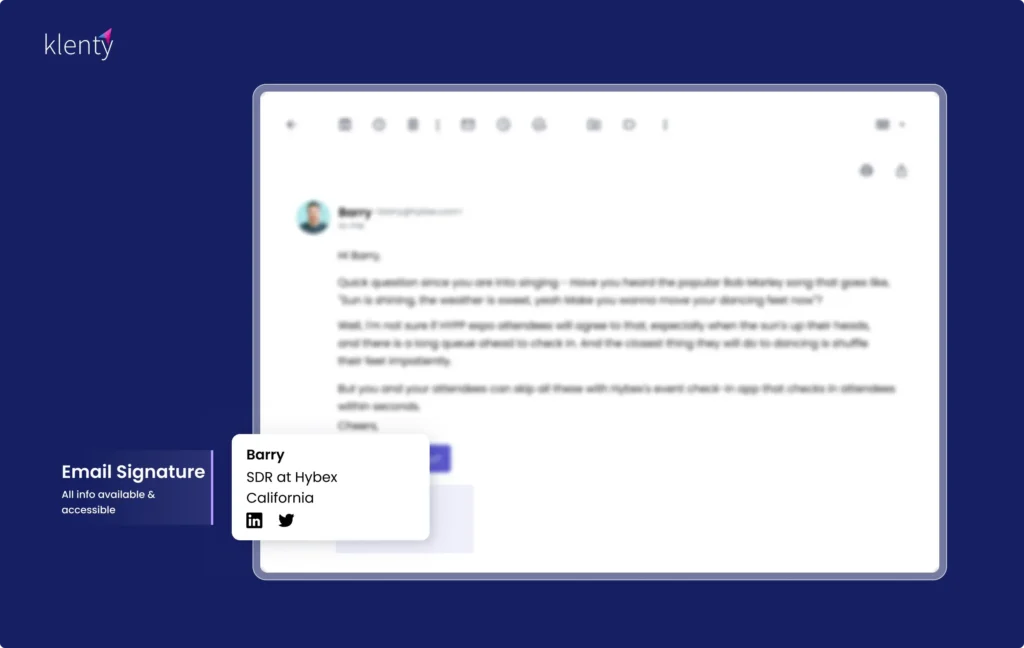
An email signature is that wee bit of space at the end of the email where you can showcase your company and what you do. Since the email is mostly about how you can help your prospect, this is what they'll investigate to check the credibility of your claims.
What Should Your Cold Email Signature Contain?
A great cold email signature contains 3 components. They are:
- Who am I? - This is where you include factual details like your name, title, company name, address, and social media links. But avoid mentioning your email address, as your prospect knows it already.
- Why Do I Matter? - This is where you give the prospect a reason to trust you. Give a quote or tagline, social links, or enlist your accomplishments. But never clutter it with unnecessary links that could distract the reader.
- What Do I Want You To Do - Give a link to your calendar here. This way, you are giving high-intent prospects the opportunity to book a meeting with you easily. Alternatively, you can include a trial signup page or a demo link.
Here is an example of a great email signature.
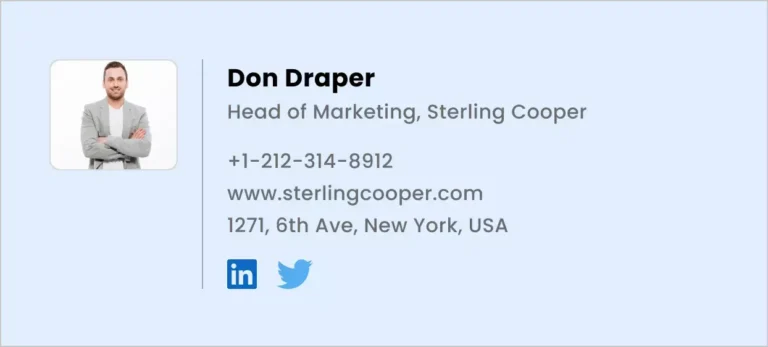
3 Email Signature Generators
- Canva - A beginner-friendly tool that offers various email signature layouts that you can tailor to your needs.
- Wisestamp - Offers various templates and customization options to create an email signature suitable for your business.
- Newoldstamp - An email signature generator best suited for iOS and Mac users.
Best Cold Email Examples for Different Sales Scenarios
While all cold emails aim to get the prospect's attention, there are some ground rules you could follow when emailing people in different roles. Cold emails are not a snug fit for every kind of prospect. For instance, you might catch the attention of prospects working at a unicorn startup by using emojis in subject lines but may end up in spam when the prospect is a C-level executive at a more traditional, enterprise-level company.
a. How To Send a Cold Email to a C-level Executive
If you've ever wondered the best way to approach a founder, be it the CEO of a Fortune 500 Company or a startup founder in your town, here's the answer: cold emails.
But most CEOs receive an average of 150 emails per day. So to ensure your emails don't get lost in the clutter, you need to approach them in a way that respects their time.

CEOs and founders love clarity of thought. When every second of their life is accounted for, they are not going to while away 2 minutes reading a joke sent by a stranger. For example, Amy Vola, CEO of Avenue Talent Partners, says, "I don't respond to funny or cute. I respond to real real". That is not to say you should never do jokes. Humor is subjective, so go over their LinkedIn profile or other social media platforms to check their preferences.
Here's an example of a killer cold email that you can send to a founder:
From Line: [email protected]
Subject Line: Podcast Episode with Virtuo
Hi Mike,
Your attendee engagement plan- the one you shared last month on Virtuo's podcast--really helped us get our audience lively again! Thank you.
You host a lot of small business events throughout the year. It got me thinking....do you struggle with rows of disoriented guests dilly-dallying over at the reception desk filling out one too many forms?
I'm asking because we, Hybevent, help our customers set up check-in apps for their events so that they can check in attendees via a QR code within seconds. So, no more crowded reception areas, endless paperwork, or unexpected wait times for guests.
Can I send you a 3 minute demo video of Hybevent’s event check-in app?
Have a great day,
Zola Hudson,
Hybevent, California
Pro Tip #2: You could use personalized videos to grab their attention. Since senior-most roles don't really have the time to read cold emails, you could take that burden of reading away to make them watch a 1-minute video. Keep the video short, and follow the email body strategy we mentioned earlier to shoot the video.
Why Does This Cold Email Work?
1. A direct subject line and personalized introduction that is valuable to the reader. Here, by talking about the prospect, the sender shows that they've done their research instead of desperately selling themselves from the start.
2. The email body is short, and the sender's ask is relevant to the prospect's business. Unlike most cold emails that pin prospects down to the wall with their sales-y approach, this one earns the right to ask first. Instead of the overconfident, "we know you are experiencing this, and here's the solution" email, this one humbly asks if the service is relevant to the prospect.
3. Founders love having the upper hand. Barging into their inboxes with narcissistic CTAs like" I'd love to book a call" or "Can we get on call at 11 AM tomorrow" rob them of their power. But the CTA here respects their time and doesn't pressure the founder. It is aimed at building a relationship rather than closing a sale (at least in the initial mail).
Wondering how to write cold emails to CEOs? Here are the 11 tips and 5 templates to grab the CEO’s eye.
b. How To Cold Email Prospects in Associate and Senior Roles
If you are writing cold emails to someone in an associate or mid-senior position, you have a rare chance of pushing your limits. We mean, dig into that bag of jokes, crazy pattern interruption techniques, and personalization tactics. Younger people can be more receptive to humor in sales emails. So, you can experiment with a casual tone, jokes, emojis, memes, or even personalized images.

Here's an example of an informal cold email:
From Line: [email protected]
Subject Line: Xenex's Annual Event
Hi Rami,
We helped the Chicago Cubs go from 300 to 3000 unique site conversions in under 5 months. Honestly, it was one of those 'Cinderella' moments for us.
Guessing that you might be pushing out content regularly but are unable to convert the incoming traffic--just like the Cubs?
It's quite common for newly scaling companies to face such issues. We interviewed 10 digital marketers who 3x their website's conversion rates to discover what mix of content and CRO activities they deployed to convert visitors.
I'm writing to check if you'd like to watch, listen or even read the transcript of the interview.
Mike out,
SDR @ Klenty
California, U.S
What Makes This a Good Cold Email?
1. The sender isn't barging in with a generalized solution they think the prospect needs. Instead, they take pains to find the prospect's problems and provide a solution that isn't their product (which is impressive and the best way to build a relationship).
2. The case study is the cherry on the top. It is highly relevant to the prospect (a Cubs fan!) and data-driven.
3. While choosing CTAs for cold calling a prospect, don't worry about who has the upper hand. Instead, focus on clarity and flexibility.
c. Cold Email Example for Networking
Did you know that sharks (not the VC gurus you see on the ABC channel) never miss an opportunity they get to meet other sharks? Doing so helps them develop long-term relationships with fellow sharks to share information about preys and to learn hunting tricks from each other.
In other words, they live by the quote, "your network is your net worth."
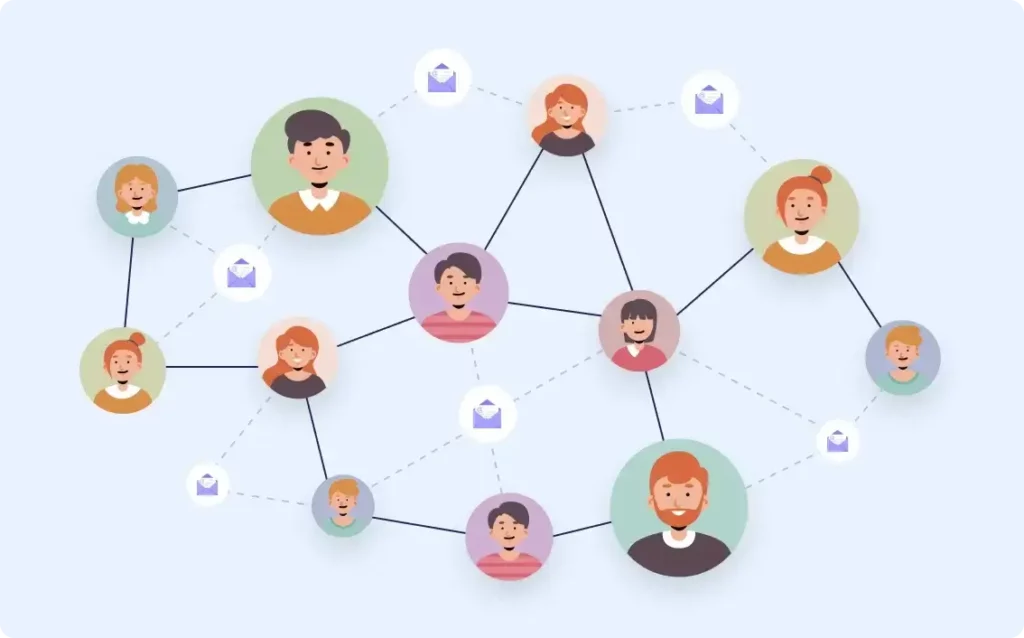
So, if you are an SDR who's starting out and are not sure of how to build a network, start today. (If sharks can do it, you can, too.)
Here's an example of a cold networking email.
From Line: [email protected]
Subject Line: How are you staying so productive!
Hey Liz,
I know this is out of the blue. But I came across your recent LinkedIn post on improving productivity, and–crazy coincidence–I had just started practicing time blocking last week. Definitely going to test out the rest of your tips. Here's a book one of my former managers swear by on productivity tips for SDRs–{amazon link}.
I was actually scouring the web for SDR productivity tips because I'm scaling my team. I'd love to know your thoughts on improving the team's productivity.
It would be great if we could catch up sometime this week. Let me know.
Ciao,
Roger
SDR, Rodex, Los AngelesWhat Sets This Cold Email Apart?
- It is not just another spray-and-pray-style networking cold email but one tailored for the prospect.
- The specificity of the cold email CTA is another factor that makes it stand apart.
- The conversational style of the email makes it more personal.
d. Following Up on a Cold Email After No Response
Cold email expert Alex Berman says, "Most businesses I pitched to during my initial years didn't give me a response no matter how good the initial email was until I sent them a follow-up,".
To get a reply from your cold email campaign though, your follow-ups should be as valuable to the reader as the first cold email.
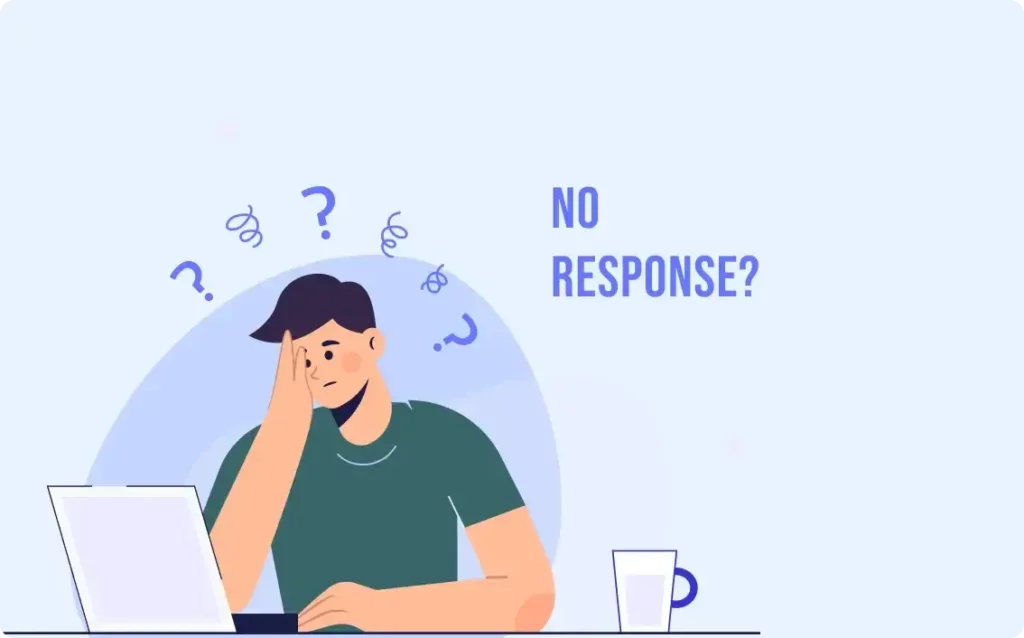
You can follow the same format of writing a cold email: A personalized hook as an introduction and a WIIFT. Because, irrespective of whichever follow-up you're sending, chances are that it's the first time the prospect is reading it. Or even if they know you, you have to reiterate your value prop for them to remember you and see value in what you provide. And without fail, you have to deliver something of value in every email.
Those emails that have a simple – 'just following up' – introduction will fail because if your prospect has not read your cold email in the first place, this is a bizarre opening line.
Here's an example of a follow-up email after no response:
From Line: [email protected]
Subject Line: A gift for you and your company
Hi Amelia,
I know how busy you must be managing your SDR team and helping them increase productivity. I sent you some information about Wandex, our sales engagement platform a while ago, and I noticed that you checked them out.
Why don’t you take Wandex for a run? Here are a few vouchers that you can use to kick our tires for 2 weeks.
SDRs I know personally have boosted their productivity 3x since using Wandex. So, I’m positive that your colleagues will feel at the top of their game upon using it.
I’d love to show you how to take Wandex for a spin. Can we get on a call?
Regards,
Jose Hilton
WandexSource from: Pipedrive
What Sets This Cold Email Apart?
- It follows the principle of 'give to get.' In other words, you do a favor for your prospect before asking them to do something. So, the chances of your prospect reciprocating your favor are high.
- You are offering a no-commitment trial, so the prospect will be more ready to respond.
Looking for more ways to follow up after no-response? Here are 13 unique follow-up email templates to get a response from your prospects.
e. How To Send a Cold Email To Introduce Your Product

Nothing can sound more salesy and desperate than a cold email about your product. But it needn't be that way. You can make it compelling and a lot less salesy, that your prospects will be more open to checking it out. Here's how:
- Instead of blabbering about your product, personalize your emails and find a way to tie your product to the personalization.
- Don't make it all about your product. Instead give them reasons they should check out the product. How does the product make a difference? What are the pain points they solve? Talk about that.
- Give them liberty to decide whether to book a meeting with you. In other words, go for less pushy CTAs.
Subject Line: Missed Tax Deadline!
Hi Martin,
Let's just say you realized Hybex missed a tax deadline. You, Hilton, and Gary look for an extended deadline, a way to avoid penalty, and of course, take a vow never to miss another tax deadline.
And that's where OntimeHR can help you.
With a dashboard of a detailed breakdown of every state and federal tax payable by Hybex, missed tax deadlines will soon be a thing of the past.
What's the best way to show this to you, Martin?
CiaoWhat Sets This Cold Email Apart?
- The email follows the 'show, don't tell' format. It reels in the prospect by vividly describing their pain points and organically introducing your product as the solution.
- The introduction is quite pattern-interrupting. It takes the prospect into the media-res (middle of things) of a probable situation and even name-drops some of their colleagues.
- Instead of breathing down their neck for a meeting, the prospect asks if knowing more about the product is worth their time. This CTA encourages the prospect to reply more than a pushy one.
How To Ensure a Successful Cold Email Campaign?
A cold email campaign can't be set up within a snap of a finger. It takes days of blood, sweat, and tears (this one could be literal) to build prospect lists, craft, and send emails. But all this hard work goes down the drain if your campaign has more bounce rates than conversion rates.
Here are some things you should consider to ensure it doesn't happen:
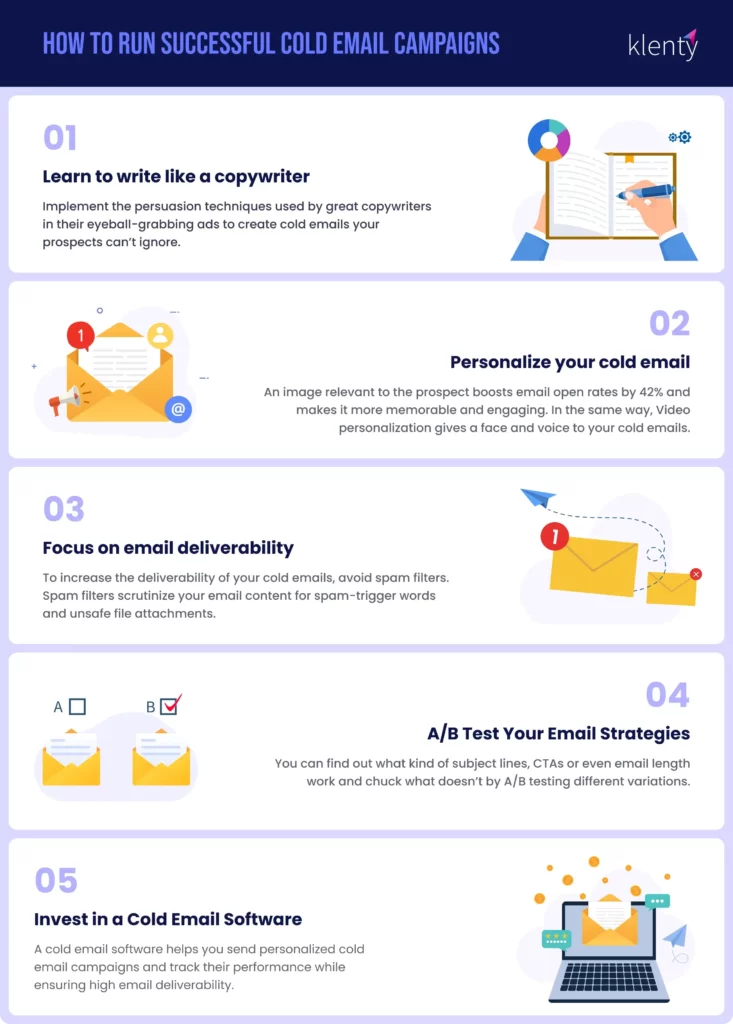
1. Look Up To Great Copywriters
What makes a cold email great? Its ability to grab the target audience's attention and make them take the desired action.
And if you are wondering if there's an easy way to craft a great cold email every time, here's a secret – look up to great copywriters like Oglivy and Halbert. Implement the persuasion techniques they used in their eyeball-grabbing ads to create cold emails your prospects can't ignore.
Here are 8 cold email copywriting techniques from experts to hook your prospects here.
2. Using Personalization Techniques
Personalization isn't always about getting your prospect's name right or inserting them strategically inside the cold email. Even though this part is indispensable, nowadays, you need to put in more effort to deserve your prospect's attention.
Here are some of the ways in which you can hyper-personalize your emails:
- Image Personalization
If you want to add some extra charm to your cold emails, image personalization is the way to do it. An image relevant to the prospect boosts email open rates by 42% and makes it more memorable and engaging. It conveys more in fewer words and stands apart from the heap load of text-based emails.
Here’s what Nandhitha Menon, SDR at G2 says about personalizing emails with images:
“I attach screenshots of dashboards comparing the G2 profiles of the prospect and their competitor. This would help present the statistics in a better manner and also enables prospects to look from a buyer’s perspective.”
- Video Personalization
Video personalization gives a face and voice to your cold emails. It helps your brand appear humane and approachable. This drives click rates and reply rates. But since sending personalized videos to all prospects is practically impossible, it is better to send them only to high-value prospects. A cold email software like Klenty helps you do this. It targets your hottest prospects and lets you send and track personalized videos.
3. Increase Email Deliverability
Email deliverability is the ability of your emails to land in the recipient's primary inbox. If the reputation of your email is less, they end up in the spam folder or other tabs of the inbox and affect the success of your cold email outreach.
To increase the deliverability of your cold emails, avoid spam filters. Spam filters scrutinize your email content for spam-trigger words and unsafe file attachments.
If your cold emails contain any of these, it gets thrown into the spam folder instead of the prospect's inbox.
Want to land in your prospect's inbox every single time? Steal our 3-step framework to improve email deliverability and avoid spam folders.
4. A/B Test Your Cold Email Strategies
If you've ever wished to read your recipient's minds, running an A/B test for your emails is the closest you can get to it.
You can find out what kind of subject lines, CTAs, or even email length work and chuck what doesn't by A/B testing different variations.
To A/B test your emails, first choose the metric you want to track like open rates, click rates or reply rates. Next, divide a list of prospects into sections A and B, and start your cold email campaign for both of them with one aspect you want to test – like the subject line. So for both lists, send different subject lines with every other email component remaining the same. The one that performs better is the winner. Albeit, you'll need to use an email automation software to run such tests.
5. Invest in a Cold Email Software
Sending a highly personalized email to 10 prospects daily is easy. But what if you've to reach out to 100s of prospects every day? If that's the case, how can you personalize your emails at scale?
The answer? Use a cold emailing software. A cold email software like Klenty helps you send personalized cold email campaigns and track their performance while ensuring high email deliverability. It offers various features to personalize your email, like Liquid Templates, and allows you to send them when the prospect is more likely to see them.
On top of that, Klenty automatically moves your prospect to different email sequences based on the prospect's buying intent. For instance, if a prospect is opening all your emails, it shows that their buying intent is high compared to someone who hasn't opened a single email. Klenty identifies this and moves the prospect to a more apt email sequence to increase the chances of them buying from you.
Resources You'll Love
FAQs on Cold Emails
How many cold emails should you send per day?
While there's no clear-cut answer to how many cold emails you can send per day, it is always best to start small to warm up your email account. You can gradually increase the number of emails as your account gains more domain reputation. But avoid sending more than 200 emails per day to be on the safe side.
Is cold email illegal?
Here are some tips to avoid getting blacklisted while cold emailing:
- Reveal your identity in the email
- Avoid clickbait subject lines
- Send relevant emails to your prospects
- Provide an opt-out link
To know more about CAN-SPAM compliance

